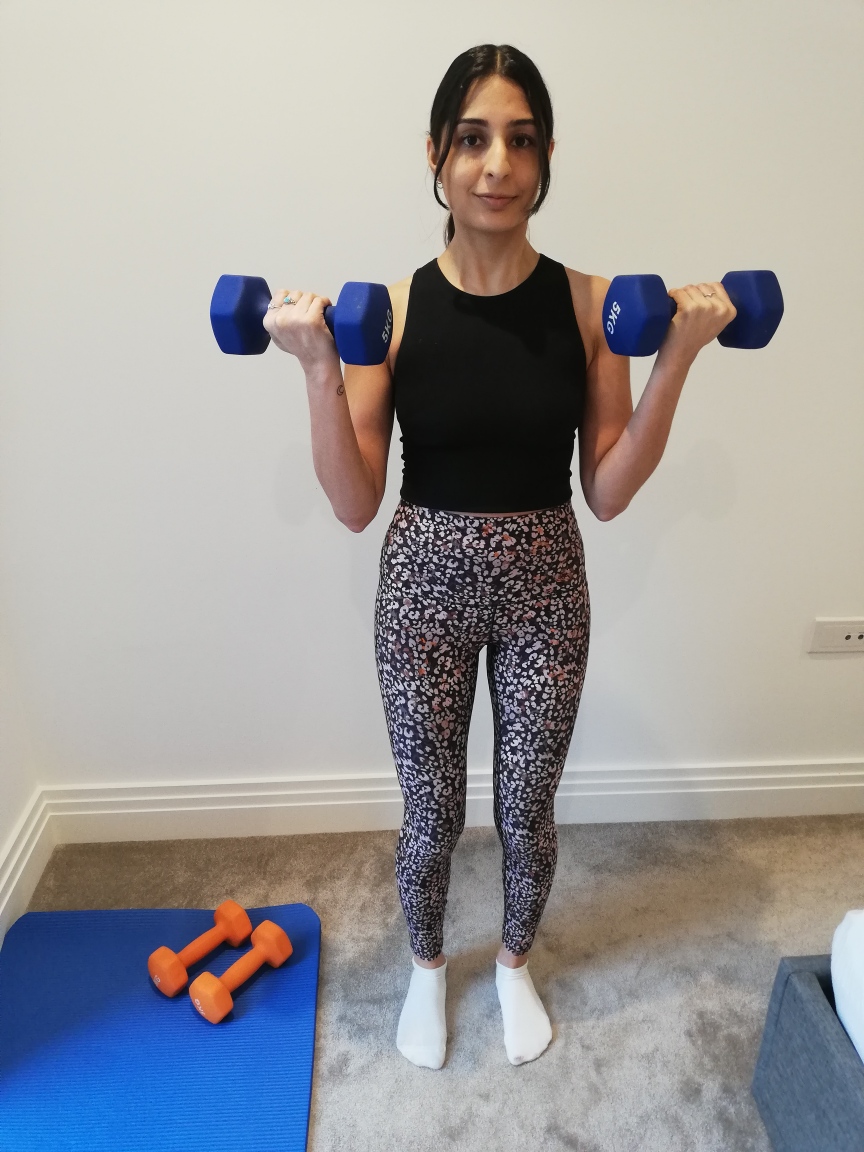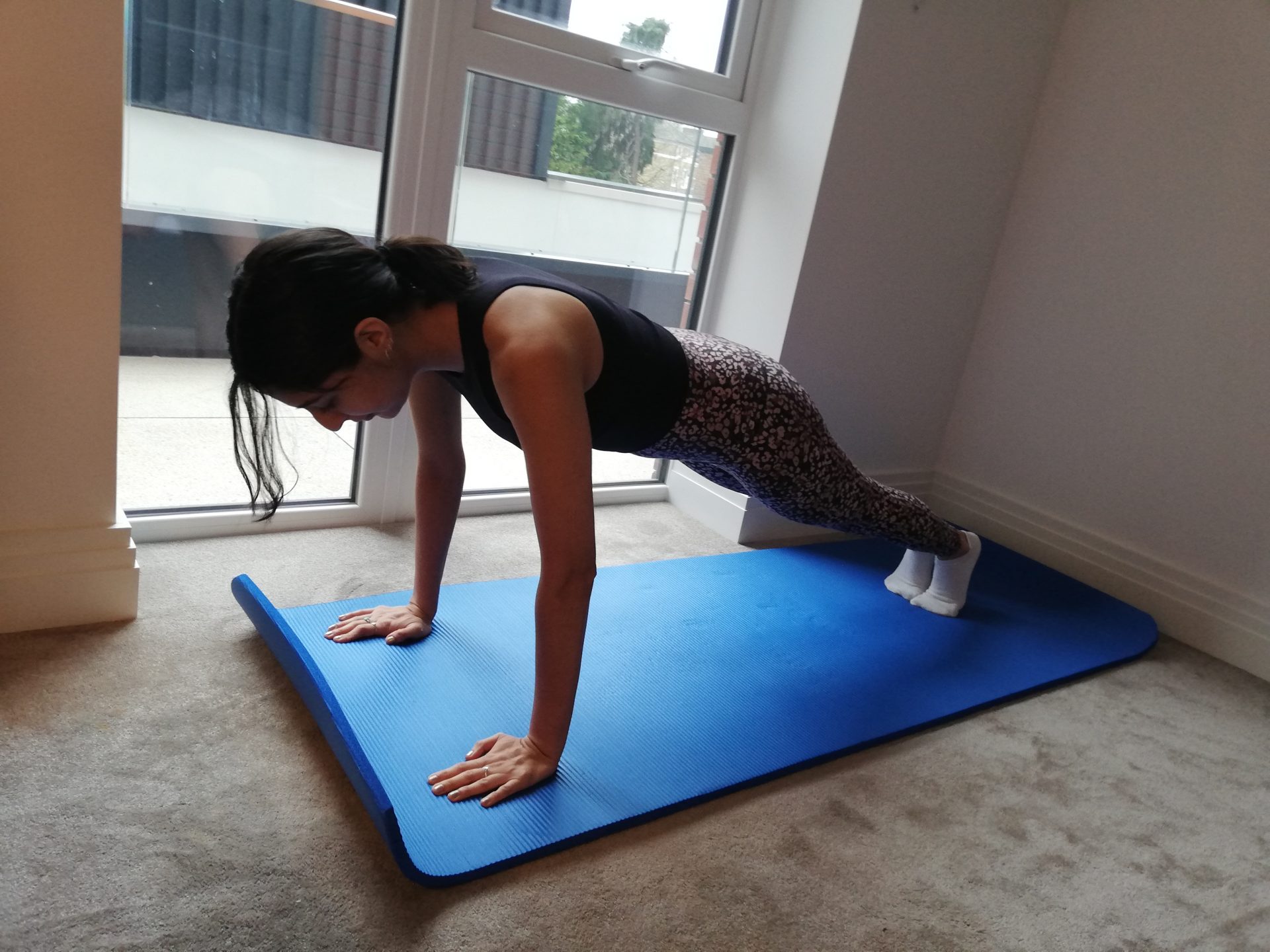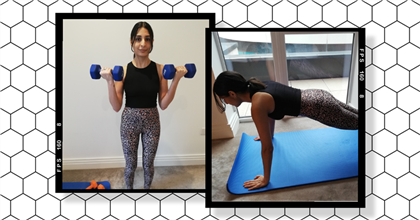Looking for a fitness challenge to kickstart the new year? One writer – who has always struggled with push ups – took on a 30-day challenge to try and master the upper body move. Here’s what happened…
We all have that one exercise we love to hate. For some it’s burpees, for others it’s the plank, but for me it’s push ups. I know they’re fantastic for building upper body strength but I find them really tough. As such, I’ve always avoided them in my workouts, swapping them out for other exercises or opting for the easiest, modified version I can manage.
So, when Stylist’s fitness editor Miranda asked if I was up for taking on the Strong Women Training Club four-week push up challenge, naturally, I was reluctant. But after giving it some thought, I realised it would be the perfect opportunity for me to finally get over my fear of push ups and develop some strength in my upper body – an area which I tend to neglect.
Before I could change my mind, I told Miranda I was in and she sent over the four-week training programme. Read on to see how I got on.
THE BENEFITS OF PUSH UPS
To boost my motivation ahead of the challenge, I wanted to find out why incorporating the dreaded push up into my workout routine would be a good idea.
“Not only is it great for developing strength, endurance and hypertrophy (size), it’s also a fantastic way of preventing injury by way of joint stability, mobility and body control,” Ben Cunnington, a personal trainer at Nuffield Health, told me.
Push ups primarily work your pectoral muscles (chest), triceps (back of arms) and deltoids (shoulders), Cunnington explained, but they’re also great for strengthening the lower back and the core, including abs and glutes.
“They’re easy to do in small spaces like a bedroom or hotel room, they can be modified to suit your fitness level, and you don’t need any equipment,” added Lucy Arnold, PT and founder of inclusive fitness clothing brand Lucy Locket Loves.
Plus, they’re the type of move you can incorporate into your routine regularly, unlike weight training moves such as the chest press or shoulder press which require rest days in between for recovery.
WHAT IS THE FOUR-WEEK PUSH UP CHALLENGE?
The training plan, designed by Strong Women trainer Janine George, consists of two workouts per week, with the aim of building up enough strength to nail up to 10 consecutive full push ups by the end of the month.
I assumed I would have to perform endless push up variations each day but I was delighted to find out that this wasn’t the case. Each workout in the plan starts with a warm-up followed by one or two strength circuits, which include a range of exercises to complete three times. Then, it’s time to attempt some push ups (this section becomes more difficult as the challenge progresses), and finally, there’s a cool down.
“This four-week eight-workout challenge will physically prepare you to perform one push up or a set of push ups, depending on your level,” George told me. “You can expect to see muscular definition and have an overall stronger upper body, particularly your arms, chest and core.”
You do need some kind of weight to complete the workouts, but if you don’t have access to dumbbells, you can do the moves with water bottles or tins of beans.
After looking over the challenge and seeing the exercises, I found myself excited to get started and to see if I really would be able to nail a set of push ups by the end of the month.
WHAT IS THE CORRECT WAY TO DO A PUSH UP?
Before jumping in, I wanted to make sure my form was correct so I asked Arnold to explain how to perform a box push up, the first push up variation in the challenge, properly.
Here’s how to do a box push up:
- Place your hands on a box or a raised surface like a kitchen countertop, slightly wider than shoulder-width with your arms straight and your feet hip-width apart.
- Pull in your belly button and squeeze your glutes.
- Bend your elbows to lower your chest down towards the edge of the surface, keeping your elbows tucked in.
- Pause and hold before extending your arms and pushing yourself back up. Make sure your body remains in a straight plank position throughout.
- Repeat.
HOW TO PERFORM A FULL PUSH UP
I also needed to brush up on how to perform a full push up, so Barry’s instructor Honey Fine offered some advice:
- Start by taking a high plank on your hands and toes, making sure your shoulders are stacked over your wrists.
- Make sure your core is activated so you’re pulling in your belly button and squeezing the glutes.
- Slowly lower yourself to the ground, letting your arms and elbows come out to 45 degrees.
- Stop when you’re about halfway down.
- Exhale, squeeze your muscles and drive back up into a high plank position.
Push up challenge week 1: getting started
I decided to complete the first workout of the challenge on Monday morning before work as I was feeling positive and motivated after a restful weekend. It took about 40 minutes in total, although I was probably a bit slower as I took some time getting to know the moves and checking my form.
After finishing the strength circuits, which included upper body exercises like bicep curls and dumbbell pullovers, I moved on to the push up focus, which required me to do two box push ups. I managed to do them, and surprisingly, I found I even enjoyed them. Although it had only been one day, I felt strong and accomplished afterwards.
I did the second workout of the week on Thursday to give myself a few days in between. The exercises in the strength block included a high plank, single-arm bent over rows and tricep extensions, and after completing all the sets, I really felt it in my arms and shoulders.

Today’s workout called for three box push ups, which again I was able to do, and it felt great. I’ve never been a big fan of knee push ups but doing them like this was quite enjoyable for me. So much so that I even found myself practising them outside of the challenge.
Push up challenge week 2: making progress
This week’s sessions were similar to week one, with the addition of some new and more challenging moves. For instance, the kneeling renegade rows from week one became full renegade rows in week two and the bicep curls were swapped for hammer curls with a press.
I wanted to put my all into this challenge so I really pushed myself, using the heaviest dumbbells I could manage for each move while making sure my form was correct. I would say it’s worth familiarising yourself with the exercises beforehand to ensure you’re performing them properly, and so you don’t waste time during the workout.
By the end of week two, I was able to do five box push ups. It might not sound like much but after completing the intense upper body circuits, my arms felt like jelly!
All in all, week two was much harder, but I was still feeling positive about the challenge, which I didn’t expect. Was I becoming a push up convert?
Push up challenge week 3: upping the ante
As I entered week three, I felt nervous. This was because there were no more box push ups, it was time to start practising full push ups. Gulp.
The class structure changed slightly too, with one long strength circuit to be repeated three times, instead of two short ones. Exercises ranged from bear crawls and low plank to renegade rows with a push up (these were tough and I had to drop to my knees for some).
George told me she selected these particular moves because they targeted all the right muscles for a push up, and wow, I really felt it. On both days, the first round was OK, the second felt tough, and by the third, I really felt the burn in my arms, shoulders and chest. For many of the exercises, I had to lower the weight at this point.

Afterwards came the full push ups. On day five, the challenge suggested attempting four of them but this was too much for me. I did, however, manage one full push up and I was over the moon. I found pushing back up hard but nonetheless, I did it. This is something I wouldn’t have been able to do prior to the challenge, so knowing I was improving was incredibly motivating.
On day six, the suggested number of push ups was six but I was only able to do three before collapsing onto my mat. Still, for me, this was a huge success.
Push up challenge week 4: the final push
As I entered the final week, I was determined to give it my all and see how far I could get.
Outside of the challenge, I dedicated some time to building upper body strength. As suggested by personal trainer and fitness influencer Carly Rowena, I incorporated exercises like the chest press, tricep dips, commandos, crab taps and the plank into my regular workouts. “These moves will help strengthen the muscles you use when performing a push up,” she told me. I also practised my push ups, doing a few box variations or full push ups each day. I think this really helped.
On day seven, the penultimate day, I managed four full push ups. Three days later and with some push up practise in between, I embarked on the final class. On day eight, I was able to perform a grand total of six consecutive full push ups followed by three push ups on my knees. And just like that, the challenge was complete.
PUSH UP CHALLENGE VERDICT
After finishing the month-long challenge, I was strangely sad that it was over. Seeing my progress over the weeks was so encouraging and I felt a huge sense of achievement. I never thought I’d be able to manage one full push up let alone six consecutive ones, so I’m really proud of myself.
In terms of physical changes, my upper body feels a lot stronger, as does my core. I’m not saying I’ve made huge gains, but since completing the challenge, I’ve been able to lift slightly heavier weights when doing upper body exercises.
I found the challenge easy to fit into my routine – two days a week is manageable for most of us, each workout was fun and snappy, and I could do them in my bedroom as I didn’t need much space.
For me, the biggest revelation has been that I actually quite like push ups, and I’m definitely going to incorporate them into my routine going forward. On reflection, I think it was a mental barrier that stopped me from doing them in the past.
Now, I’m excited to keep going with them and my aim is to reach 12 consecutive full push ups. I’ll also be continuing with many of the exercises in the challenge, as I know they’re extremely effective and efficient for strengthening the upper body muscles.
If you find push ups daunting, I’d suggest biting the bullet and incorporating some push up variations in your training. You never know, you might become a convert like me!
PUSH UP CHALLENGE TIPS
- Practise the strength exercises and push ups beforehand to make sure you’re performing them correctly and you’re getting the full benefits.
- If you’re unsure, watch a tutorial or ask a coach to check your form.
- Outside of the challenge, make sure you’re working on your upper body strength. Cunnington suggests exercises such as the dumbbell bench press, incline press, chest press and reverse fly.
- I found bodyweight moves like tricep dips, high plank and commandos particularly effective too.
- Rowena offers a reminder to be gentle with yourself, particularly if you’re a complete beginner. “Push ups are hard! Some days, you’ll feel like you can keep going and others, just one push up will send your body into a world of pain. It’s all part of the process but have faith and keep going,” she says.
- As the challenge only takes up two days per week, do try and fit in some push ups on the remaining days to keep up the momentum.
To join the push up challenge, sign up to your free two-week Strong Women Training Club trial.
Images: author’s own
Source: Read Full Article
